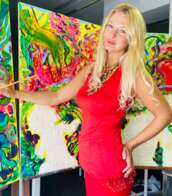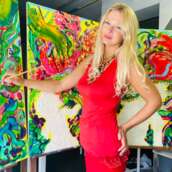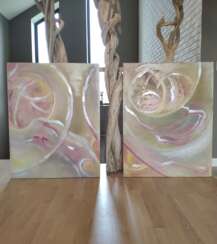2 Items by auctions and galleries:
north german expressionism
Lot 11 Ernst Barlach. Der singende Mann
Ernst Barlach (1870 - 1938) .jpg) A541: Evening Sale
A541: Evening Sale 
.jpg)
Ernst Barlach
02.01.1870 - 24.10.1938
Germany
Ernst Heinrich Barlach was a German expressionist sculptor, medallist, printmaker and writer. Although he was a supporter of the war in the years leading to World War I, his participation in the war made him change his position, and he is mostly known for his sculptures protesting against the war. This created many conflicts during the rise of the Nazi Party, when most of his works were confiscated as degenerate art. Stylistically, his literary and artistic work would fall between the categories of twentieth-century Realism and Expressionism.

VAN HAM Kunstauktionen GmbH
A541: Evening Sale
Date: 03.12.2025 18:00 UTC +01:00
Number of lots in the catalog: 519
Дыхание вселенной
Alla Aleksandrovskaya (b. 1989)  Shop Aleksandrovskaya Alla
Shop Aleksandrovskaya Alla

Alla Aleksandrovskaya
23.03.1989
Russia
Я родилась в семье художников, наблюдая за мамой с ранних лет я занималась скульптурой и живописью. Исследуя мир вокруг я пыталась понять и осмыслить реальность и определить своё место в ней. Изучая философию и психологию я нашла собственный язык приемы и средства для выражения сложных, для визуального отображения сюжетов. Исследую проблемы мироздания, жизни и смерти, тему конечности. Вопросы которые я задаю, созвучны с сложившимися в древности религиозно-мифологическими представлениями и поисками, но я предаю им тонкую психологическую нагрузку и пытаюсь раскрыть так, как я это вижу чувствую. Придерживаясь мнения, что не существует объективного положения вещей и точного определения общей для всех реальности. В своих исследованиях я не ограничиваю себя рамками одного сюжета -это симбиоз психологических практик,практических экспериментов и философских поисков.
I was born into a family of artists. Watching my mother from an early age I was involved in sculpture and painting. Exploring the world around me, I tried to understand and comprehend reality and define my place in it. Studying philosophy and psychology, I found my own language, techniques and means to express subjects difficult to visualize. I explore the problems of creation, life and death, the theme of finitude. The questions I ask are consonant with ancient religious and mythological ideas and searches, but I give them a subtle psychological load and try to reveal them as I see them. I adhere to the view that there is no objective state of affairs and no precise definition of reality common to all. In my research I do not limit myself to a single subject; it is a symbiosis of psychological practices, practical experiments, and philosophical quests.

Artist shop
Aleksandrovskaya Alla
Russia
Number of products: 7



